Our favorite homemade remedy for sprains and bruises is Yarrow and Arnica Bruise Cream. Arnica is known for its pain-relieving properties and yarrow herb is highly regarded for bruises and sprains.
I make this salve every year when the arnica blooms in the forest around my homestead. This is my go-to remedy for sprained ankles, pinched fingers, banged shins and the myriad of other accidents that happen day-to-day on the homestead. Its also great to take to the beach or to tuck in the travel bag. I used this sprain and bruise cream when I tripped over a hose and banged my shin on the cement step a few weeks ago. I used it when I slipped on a wet garden path and wrenched my ankle. I used it when Mr. Joybilee pinched his finger between the wheel barrow and the ice when he was cleaning out the barn. Its a tried and true remedy for minor injuries that don’t require a trip to the emergency room. In fact its save us a few trips, allowing us to deal with an injury within a few minutes instead of waiting for things to get worse.
There is no better way to get relief than to combine the pain-relieving properties of fresh arnica plants with the antiseptic, anti-inflammatory and astringent properties of yarrow, which is highly regarded for healing wounds, bruises, and sprains. These two herbs are key to quickly reducing inflammation, soothing irritated skin, reducing swelling, and restoring blood vessels. Use this salve on sprained ankle pain, minor bruises, or sore joints and muscle inflammation. Made from the infused oil of fresh, whole Arnica flowers, and fresh yarrow blossoms and leaves, this salve reduces discoloration, swelling, and pain from bruising.
Making Homemade Healing Salves
Homemade salves are a good way to tap into the benefits of the herbs you have growing in your own back yard. Salves deliver the medicinal actions of herbs directly to the body via the skin. Salves are often used for skin conditions, bruising, dryness, rashes, boils, and abrasions, but they can also be used to deliver warmth and anti-inflammatory actions to the body.
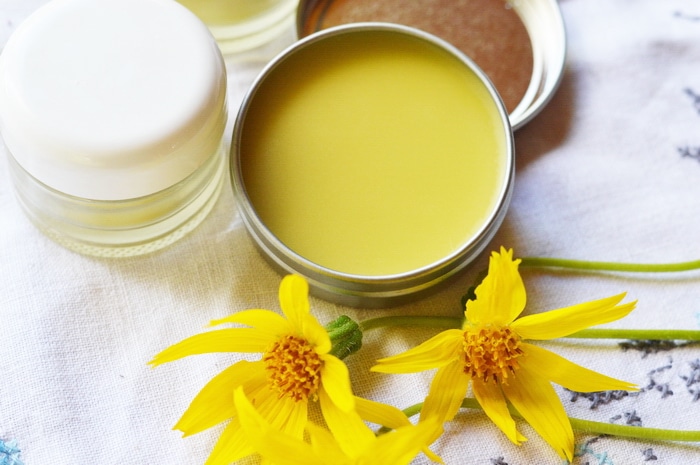
Get to Know Arnica
One of the plants of the asteraceae family, Mountain Sunflower, or Arnica montana, is a bright yellow, daisy-like flower that blooms in Spring on nutrient-poor hillsides, rocky places, and stony plains. The plant is toxic if ingested in large quantity but highly beneficial when used topically or as a highly diluted homeopathic tincture.
Do not use this remedy internally. Fresh arnica should only be used on unbroken skin and should not be used internally. Arnica tablets are homeopathic medicines, used in traditional homeopathic practice for accidental injury, shock, and pain. Homeopathic dilutions can be used internally because the actual active ingredients in the arnica are diluted with purified water many hundreds of times. However, in this remedy the arnica is used full strength.
Arnica was found to have the same pain-relieving, anti-inflammatory effect as Ibuprofen (5%) when used in a gel at 50% concentration. This is the same concentration that you would get if you infused the flowers in olive oil. There are reports in the literature of paralysis being healed with the use of arnica, as well. Arnica is definitely an herb that is worth getting to know better.
It has a pungent smell, its stem is slightly fuzzy, soft, hairy leaves. The name arnica comes from the Greek “arni” meaning lamb for this characteristic. The whole plant is used in herbal medicine, but since it is a perennial, most herbalists leave the plant in the ground and only harvest the flower heads.
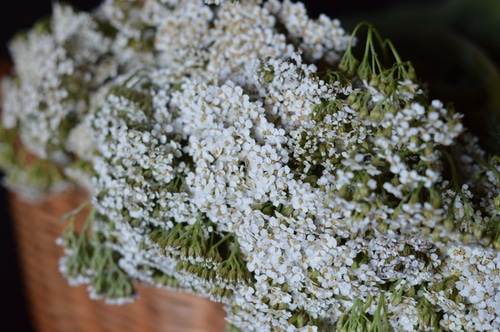
Yarrow
Another asteraceae family flower, or compositae flower, Yarrow (Achillea millefolium) is a plant of waste places, roadsides, and meadows. The wild plant has white flowers and some wild plants may have pinkish blooms. Garden plants can be red, orange, or yellow. The foliage is feathery. Both the garden varieties and the wild plant can be used for this salve recipe.
The plant is perennial with two kinds of growth in the season. Long feather leaves come up from the base of the plant in midsummer and remain until frost. The flowers stand about 12 to 18 inches tall, with a cluster of tiny flowers making up each flower head. In the garden, yarrow can grow quite tall, when given adequate moisture and fertile soil.
Yarrow is commonly known as Soldier’s Woundwort, for its ability to staunch bleeding and prevent infection in wounds. There is a scene in the Iliad, where Achilles is instructed by the centaur Chiron to use yarrow to heal wounded soldiers at Troy during the Trojan War. Achilles used yarrow to cure the wounds and sores of Telephus, the son of Hercules. The ancients called Yarrow, Herba Militaris, the military herb.
Yarrow is a prolific perennial that comes in several attractive colors. While some sources say that the medicinal strength of the colored blooms is not as high as the wild plant, several selected cultivars are available. Use what you have growing in the landscape around you.
Infusing Herbs in Oil
For Yarrow and Arnica Sprain and Bruise Cream, you’ll need to start ny making an infused oil of each flower. This process, using the cold infusion method, will take several weeks so plan on starting months ahead of your travel plans.
Equipment you’ll need for infused oil:
- Wide mouth pint Mason jar
- A tight-fitting lid
- Fine Sieve
Ingredients for EACH herb infused oil:
- 2 cups Organic Virgin Olive Oil or Organic Sweet Almond Oil (or other cold-pressed oil of your choice)
- 1 cup of dried herbs or 1 1/2 cups of fresh and wilted herbs
Follow the directions in the article and after 4 to 6 weeks, strain the herbs from the oil. You can leave it up to 8 weeks if you wish. Squeeze out as much oil as possible from the macerated herbs. I often use a potato ricer to get every drop. Then bottle the oils separately in a blue or brown colored glass bottle. Cap tightly and label.
Now you have a batch of yarrow infused oil, and a batch of arnica infused oil, that are both ready to be used to make into salves, ointments, healing balms, creams, and moisturizers.
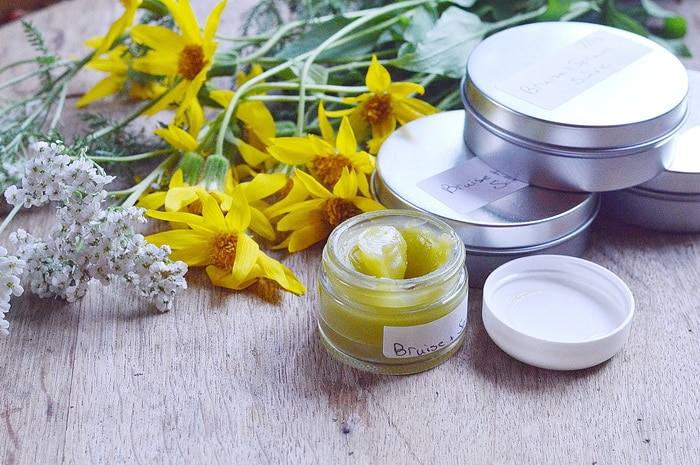
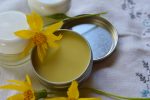
Yarrow and Arnica Sprain and Bruise Cream
- Prep Time: 5 minutes
- Cook Time: 30 minutes
- Total Time: 35 minutes
- Yield: 2 - 4 ounce jars 1x
- Category: Salve
Description
Keep this bruise salve in your first aid kit for falls, sprains, bumps, and bruises that are a normal part of an active lifestyle. Safe for all ages. External use only.
Ingredients
- 4 ounces yarrow infused oil
- 4 ounces arnica infused oil
- 2 tablespoons Beeswax
Instructions
- Make a double boiler using a glass measuring cup and a saucepan.
- Place the beeswax and infused oils together in the glass measuring cup. Heat the saucepan over medium heat till the beeswax melts completely.
- Remove from heat and pour the finished salve into two 4-ounce shallow round steel tins. Allow this yarrow and arnica bruise cream to cool completely before sealing on the lids. Label and date each tin.
Making Yarrow and Arnica Bruise Cream
Yield: 2 4-ounce shallow round steel tins
Ingredients:
- 4 ounces yarrow infused oil
- 4 ounces arnica infused oil
- 2 tablespoons Beeswax
Use 2 tablespoons of beeswax for every cup of infused oil for a spreadable consistency that will go on your skin easily.
Directions:
- Make a double boiler using a glass measuring cup and a saucepan.
- Place the beeswax and infused oils together in the glass measuring cup. Heat the saucepan over medium heat till the beeswax melts completely.
- Remove from heat and pour the finished salve into two 4-ounce shallow round steel tins. Allow this yarrow and arnica bruise cream to cool completely before sealing on the lids. Label and date each tin.
Because it is hard to control the temperature for travel storage, Yarrow and Arnica Sprain and Bruise Cream will keep in your travel bag for one year. Do your best to keep it away from heat once the jar is opened.
How to use Arnica bruise cream
Use this vitamin rich bruise cream for joint pain, bumps, and bruises where the skin is not broken. For external use only, apply a thin layer of arnicare bruise cream and massage gently into the affected area. Apply as often as needed to the damaged area until the healing process is complete.
When you should not use this DIY Bruise and Sprain Salve
Keep out of reach of children. For external use only. Arnica salve should not be used on broken skin or mucous membranes. Those who are allergic to marigold, daisies, or other plants in the asteraceae family should avoid using arnica or yarrow, until it has been determined that they are tolerated.
Do you love making a healing salve for home remedies? Check out the Complete Guide to DIY Healing Salves for Everyday Care and First Aid
I have a FREE gift for you

Grab my free ebook and learn to make DIY herbal healing salves at home now, with 14 easy to follow recipes that use the herbs and wild plants growing close to home. Salve making is one of the easiest skills to learn in DIY Herbalism.



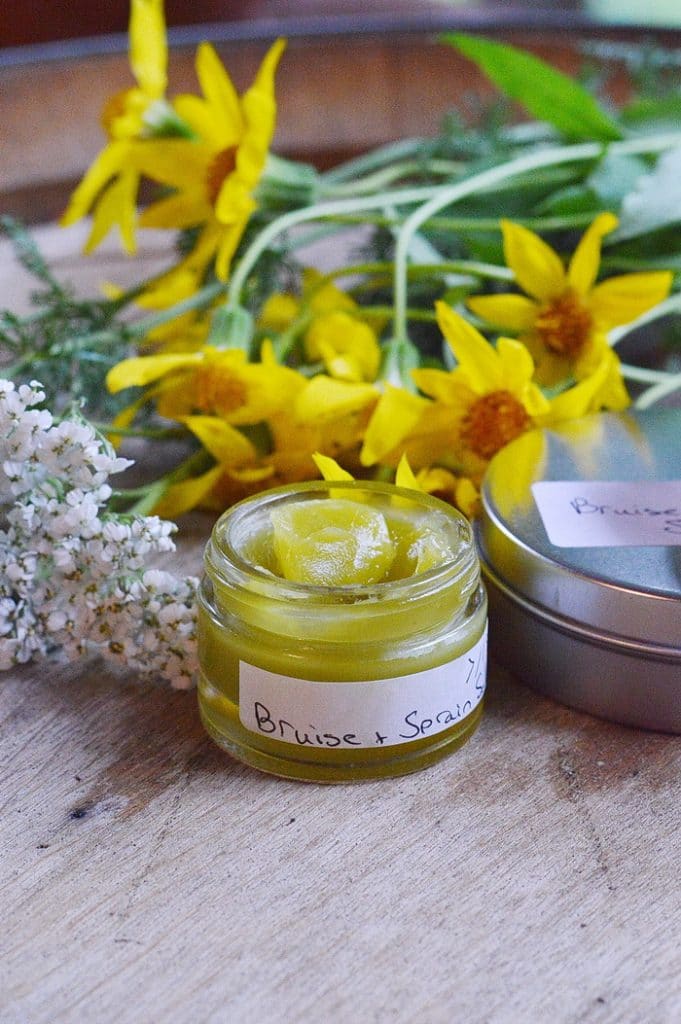

I use virgin olive oil.
What did you infuse your flowers in , what type of oil .